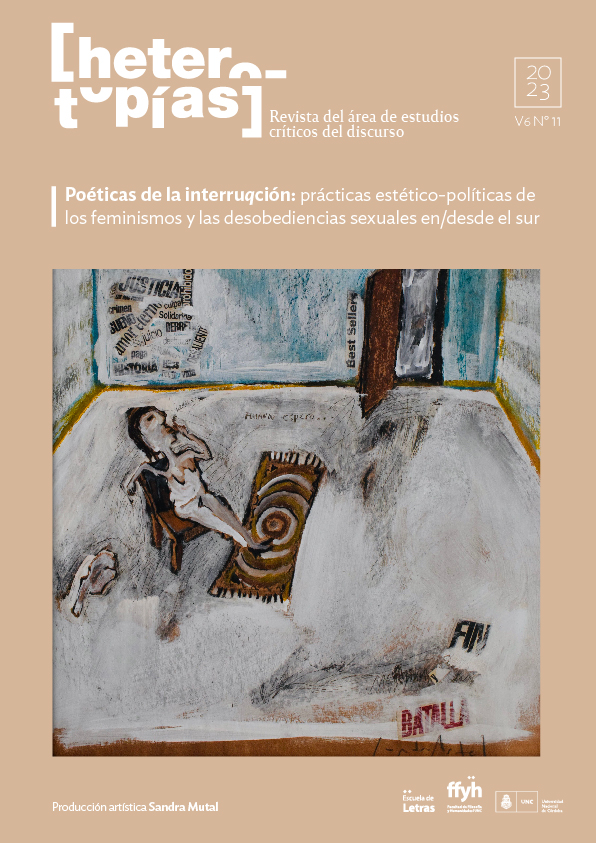Revivir para la muerte. Los fantasmas de la historia en los últimos espectáculos de Jorge Villegas
Main Article Content
Abstract
In this work we integrate the work of the Cordovan playwright and director Jorge Villegas within the Argentine post-dictatorship theater (Dubatti 2008) through a reading of the latest shows that he is putting on simultaneously in the first half of 2023 (La noche como navío , at the La Chacarita theater; La piel y la rabia, in La nave escénica; El odio, about to premiere in June, also at La Chacarita). These plays refer to an explicit offstage reference as they revive traumatic events of history (Córdoba, Argentina and universal) and can be observed as forms of theater of death (Dubatti, 2014) the poetics of the cadaveric (Musitano, 2011) or the necrotheater (Dieguez, 2014) as exhibitions of specters recognized by the viewer for the reconstruction of his death; theatrical recreation of the ghosts of history that are displayed for ask justice “…as a political object (…) as an activator(s) of memory, as a strategy of resistance to oblivion…” (Bixio, in Musitano, 2011: 14)
Downloads
Article Details

This work is licensed under a Creative Commons Attribution-NonCommercial-ShareAlike 4.0 International License.
Those authors who have publications with this journal, accept the following terms: Those authors who have publications with this journal, accept the following terms:
a. The authors will keep their copyright and guarantee to the journal the right of first publication of their work, which will be simultaneously subject to the Creative Commons Attribution - Non-Commercial - Share Alike (by-nc-sa) Attribution License; no commercial use of the original work or any derivative works is allowed, the distribution of which must be done with a license equal to the one that regulates the original work.
b. Authors may adopt other non-exclusive license agreements for the distribution of the published version of the work (e.g., deposit it in an institutional telematic archive or publish it in a monographic volume) provided that the initial publication in this journal is indicated.
c. Authors are allowed and recommended to disseminate their work through the Internet (e.g. in institutional telematic archives or on their website) before and during the submission process, which may lead to interesting exchanges and increase the number of citations of the published work. (See The effect of open access).
How to Cite
References
Amiguet, T. (1 de noviembre de 2020). Pasolini, una muerte bajo sospecha. En La vanguardia.
Recuperado de: https://www.lavanguardia.com/hemeroteca/20201101/49126109975/pier-paolo-pasolinimuerte-homicidios-misterios-homosexualidad.html
Brignone, G. (2023). Entrevista a Jorge Villegas. Original del autor.
Diéguez Caballero, I. (2013). Cuerpos sin duelo. Iconografías y teatralidades del dolor. Córdoba: Documenta.
Diéguez Caballero, I. (2014). Necroteatro. Iconografías del cuerpo roto y sus registros punitivos. En Investigación teatral, 3(5), 9-28.
Dubatti, J. (2014). Filosofía del teatro III. El teatro de los muertos. Buenos Aires: Atuel.
Dubatti, J. (2015). El teatro 1983-2013: Postdictadura (después de la dictadura, consecuencias de la dictadura). En ILCEA Revue de l’Institut des langues et cultures d'Europe, Amérique, Afrique, Asie et Australie. n° 22: La révolution théâtrale dans le Río de la Plata. 1-12.
García Barrientos, J. L. (2012). Cómo se comenta una obra de teatro. México: Paso de Gato.
García Cueto, D. (16 de octubre de 2017). Jorge Villegas: “El teatro es como un acto terrorista”. En Enredacción. Recuperado de: https://enredaccion.com.ar/jorge-villegas-el-teatro-es-comoun-acto-terrorista Hopkins, C. (27 de marzo de 2015). “Montoneros y Aramburu en clave irónica”. En Página 12. (ed. Digital) Recuperado de: https://www.pagina12.com.ar/diario/suplementos/espectaculos/10- 35079-2015-03-27.html
Jelin, E. (2002). El trabajo de la memoria. Buenos Aires: Siglo XXI. Mayorga, J. (2016). Elipses. España: La Uña Rota.
Musitano, A. (2011). Poéticas de lo cadavérico. Teatro, plástica y videoarte de fines del siglo XX. Córdoba: Comunicarte.
Tossi, M. (2015) Docudrama y autoficción en el teatro argentino de la posdictadura. En Pasavento, III(1), 91-108.
Trastoy, B. (2018). La escena posdramática. Ensayos sobre la autorreferencialidad. Buenos Aires: Libretto.
Villegas, J. (2013). Incompleto. Córdoba: Recovecos.
Villegas, J. (2019). Incompleto II. Córdoba: Del Fogón.
Villegas, J. (2021). La noche como navío. Original del autor.
Villegas, J. (2022). La piel y la rabia. Original del autor.
Villegas, J. (2023). El odio. Original del autor.
